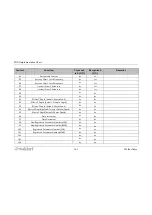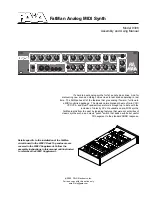
Glossary
148
Kyra Manual
PWM
Pulse Width Modulation. The technique of modulating
(varying) the width of a pulse wave to change its timbre.
When modulated by an LFO, PWM provides a very plea-
sing, chorus-style sound.
Q
Q or Q-Factor is a parameter of the mid band of Kyra's EQ
module. Higher Q values will make the band more selective
(for boost or cut). Lower Q values will make the band
wider. Filter resonance is also referred to as ‘Q’.
Quadrature LFO
A special setting for a Kyra LFO such that the LFO's output
is phase shifted 90 degrees before it is applied to the spe-
cified modulation target of the second voice of a Dual Mode
note. Compare this to the 180-degree shift when antiphase
mode is selected. The Phaser and Formant modules in the
Effects Unit also have their own quadrature LFOs.
RAM
Random Access Memory. In the context of Patch and Multi
storage, RAM allows you to store Patches and Multis quick-
ly. The RAM in Kyra is backed up with a rechargeable bat-
tery so that the contents of the RAM are maintained when
the system is switched off (either in standby or completely
powered down). RAM is, however, limited in size and Kyra
supports 7 Banks of Patch storage, each containing 128
Patches along with 128 locations for Multi storage. ROM
storage can be used to extend the capacity, please see
ROM.
Release
The fourth and final of the segments in an ADSR-style
envelope generator. The release segment starts when a
key is released or the sustain pedal is lifted and ends when
the level reaches zero. At that point, the note no longer
exists and the voice can be re-allocated.
Resonance
An attribute of a filter, typically an audio filter, whereby
feedback is used to emphasise the frequencies around the
cutoff point (and consequently, increase the roll-off rate of
the cutoff itself). Resonance adds considerable character to
a sound, especially when the cutoff frequency is modula-
ted.
Retrigger
If a note is played that is already playing (e.g. playing the
same note twice in quick succession) the note is retrigge-
red rather than another note at the same pitch being play-
ed more than once. In this context retriggering means the
replacement note will play from the level the previous one
















































